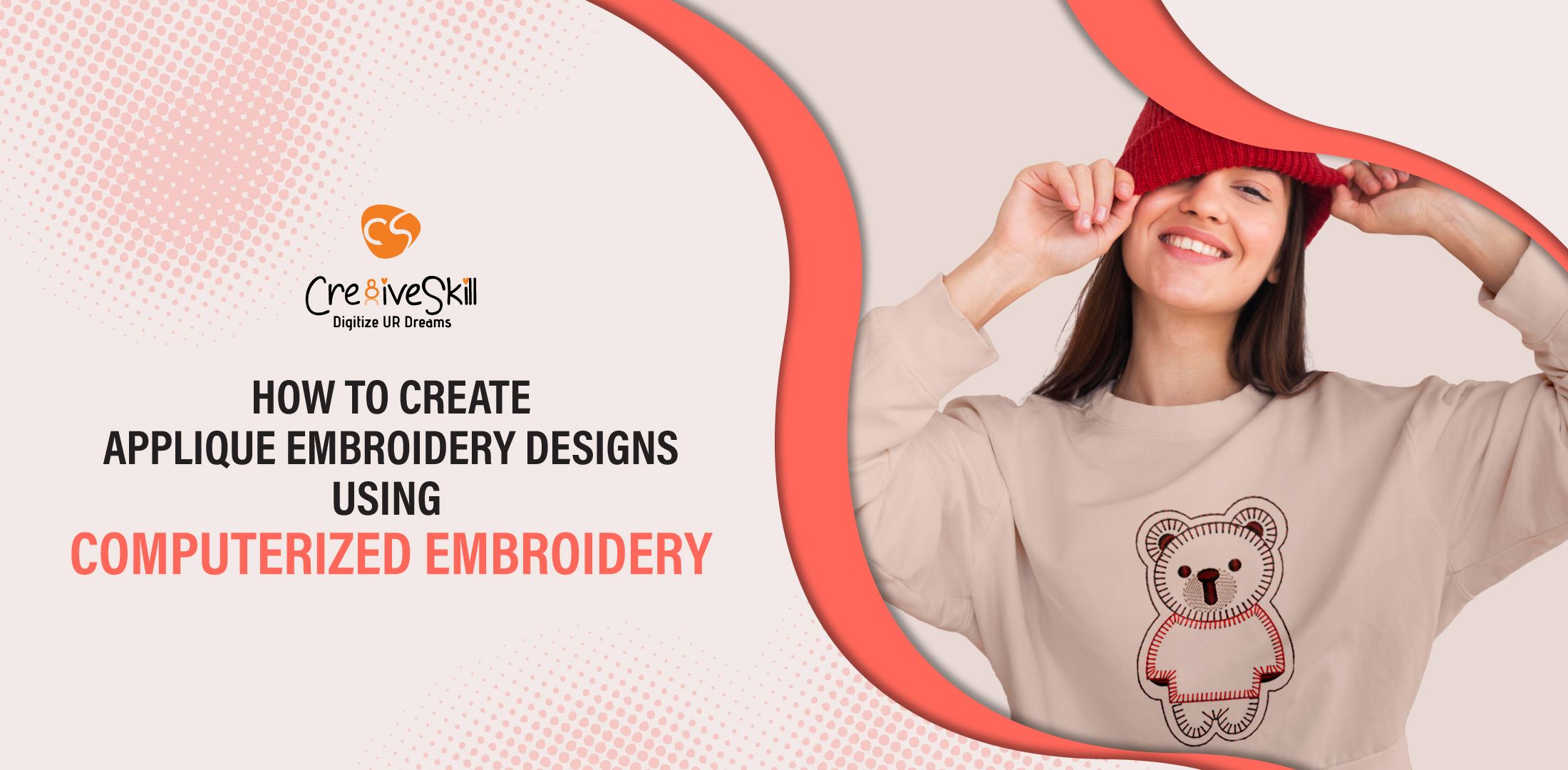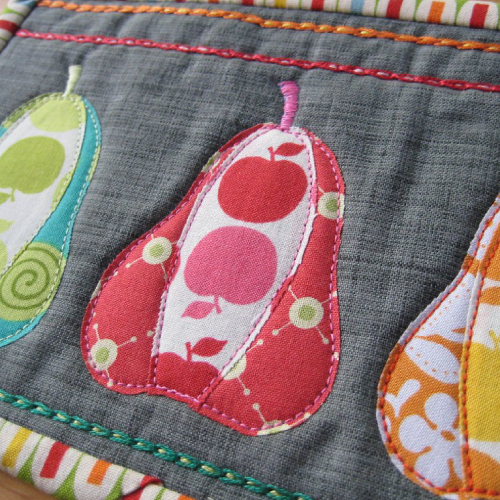How To Create Applique Embroidery Designs Using Computerized Embroidery
Embroidery DigitizingApplique is a long-aged sewing craft that uses thread and needle, in which fabrics are cut into different shapes and designs of varying sizes are sewn on a larger base fabric to form different designs. This craft is done by hand embroidery or by machine embroidery.
Creating Applique Designs
Applique is a form of embroidery, and it features a wide range of designs and can be achieved through different techniques depending on your choice. Applique embroidery designs can be done by hand and some on a sewing machine they are:
• Smooth edge applique
• Raw edge applique
• Reverse applique
• Decorative applique
Smooth Edge Applique
With the use of a sewing machine, the raw edges of the background fabric to be applied can be stitched around the shape in an attempt of getting it tidied with a chosen stitch to give a tidy finish that is smooth and neat to the user. A zig-zag stitch can give this result.
Raw Edge Applique
This design works well for ventures which will not be used frequently, as the raw edges would not be sewn over to create a seamless edge but attached to the fabric on the background. The fraying edges are left as it is. This design is ideal for smaller projects like greeting cards or wall-mounted pieces. Stronger and more durable stitches are used for items such as cushions or clothing. This design varies and can be molded according to what it is to be used for.
Multi-needle Hoop Applique
This technique is more specialized and rarely used. It is a stitching technique using a machine that requires the use of a multi-needle sewing machine as well as an embroidery hoop. Different colors, threads can be set up on the machine to be used. To create beautiful designs, each section of your design will be stitched accurately. It is best for quilting projects. This applique design is more suitable for those who have verse knowledge of embroidery.
There different sewing machines used to achieve different types of applique embroidery designs.
Reverse Applique

As its name implies, instead of sewing fabric shapes on the background fabric, using this method you layer fabrics together on top of which you need to stitch a pattern. Then to reveal the shape and color Floral reverse applique, cut away parts of the fabric.
Decorative Applique
This technique is open to different variations and arrangements. It can be achieved using a machine. If you are making use of a sewing machine, you have the opportunity of making do with different stitching styles available to make your piece appealing to the eyes. Decorative applique can be as colorful or design as desired.
The Lowdown
There are different applique choices and variations at your disposal, this technique is one of the best that has been tried and tested. For those who love playing with colors and various types of fabrics, it is the best choice of technique. You discover the applique embroidery designs that best suit your embroidery project.
Applique designs can be applied in three main methods which include; Machine applique, Hand applique, and fused applique.
With the advancement in technology, Machine Embroidery Applique has come into play due to an increase in demand as the market has fully blown into the Fashion industry.
Machine embroidery applique is fast and easy but will always ensure that the applique embroidery designs are precise and perfect. Using fabric as the background of applique designs instead of a stitched fill reduces the number of stitches of a design drastically so you can use fewer stitches to stitch a larger design.
Choosing The Right Stich For Applique Machine Embroidery

This is the most important part of applique as this is what determines if your design will last longer. Gluing or fusing your applique pieces to a background fabric is nice, but gluing alone will eventually wear out and your wonderful design will fall apart.
Some of the most common stitches used with fusible applique are zig-zag stitch, blanket stitch, and straight stitch, notwithstanding, using different stitches can give a simple quilt look beautiful.
Zig Zag Stitch:
This is a common stitch but some machines come with multiple options for a zig-zag stitch. You can get a different look with a zig-zag stitch depending on the machine settings. One can be a satin zig zag and another can be a narrow zig zag.

Narrow (Fine) Zig Zag:
This stitch is bold but cannot be compared to that of the satin stitch. The narrow zig-zag can be considered as an invisible stitch. It does the job of securing the edges of the applique designs but won’t show as a solid line of thread. The stitch has a longer stitch length and a narrower stitch width.
Satin Zig Zag:
Its name originated from the fact that the stitches look like a piece of satin. It is a compilation of very thick and dense zig-zag stitches that are closely done making it hard to see any background fabric between the stitches.
Mostly the design gives you an idea of how to go about with the stitches.

Blanket Stitch:
This is a well-known method of stitching applique and it is made up of straight stitches along the outside edge of the applique which is accompanied by a perpendicular stitch into the applique design shape. This type of stitch shows the traditional hand applique stitching style.
Most machines have multiple options for blanket stitches or might have none.

Straight Stitch:
This is an easy stitch type that may not be listed as part of stitches, but as the name implies it’s just a straight stitch.

Other stitches:
It is recommended that you create room on your stitch sampler and okay with different stitches and their settings. Blind hem stitch should also be tried in case you want to ever try out invisible machine applique embroidery and may be decorative stitches.

Choosing the Perfect Thread Color for Applique Machine Embroidery

The color of the embroidery thread is one important aspect to put into consideration when doing an applique machine embroidery. You can try the following tips :
• The vertical stitch should be outside the edge of the shape, when using a blanket stitch. The color of the thread should match that of the predominant color in the applique fabric and that of the background fabric if you find out that your applique stitches are drifting onto the applique shape as you work. By doing this, any mistakes will become less noticeable.
• Make use of a bold decorative stitch, when you don’t want to be bothered about lining the edges with needles. An example of decorative stitches is the star stitch and the rick-rack stitch.
• If the stitching is to be used as the overall design look of the quilt, use a thread that contrasts with the applique design and background fabric.
In machine embroidery, when applying stitches to the digitization of the embroidery software, digitization converts the existing artwork into an applique embroidery designs file that can be run on the embroidery machine. In other words, embroidery digitization uses embroidery software to create a machine embroidery design file with a series of commands that tell the embroidery machine how to sew the applique designs.
When it comes to embroidery, the artwork alone is not enough. In order to embroider the design with a computer, only the design file can not meet the required purpose well. Although the artwork is also vital, in the process, another skill usually obscures the former's skill. Yes, we are talking about embroidery digitizing. Like any other professional skill, the digitized file is prepared by a professional embroidery digitizer.
Nowadays, embroidery machines are very efficient and intelligent. The process is fast and quite automated. Nevertheless, this applique machine embroidery is not self-sufficient in interpreting the design. The machine cannot understand and embroider designs in simple digital format by itself.
Most clothing printing technologies can use and print from design files. Embroidery is an exception, because applique embroidery designs are made up of stitches. Digitization is the answer to bridge this gap. The digital format of the design is its stitch representation. It divides parameters such as stitch position, stitch type, stitch path, and density across different areas of the design.
The responsibility for defining these parameters lies with the embroidery digitizer. The digital format of the design is created on a computer program, usually called embroidery digitizing software.
With the resurfacing of the term "automatic digitization", which was introduced by a few embroideries digitizing software manufacturers. Regardless of its effectiveness, the term undoubtedly offers exciting prospects. The basic idea is to configure the software in a way that can be digitally designed without external input.
The design only needs to be entered, and the software will create a digital format of the design. Although this is interesting equipment worth thinking about, automatic digitization still has a long way to go. The software can recognize the design but still cannot define stitch parameters through different areas of the design. This still requires human intuition. Therefore, the role of embroidery digitizing services is still very important.


.jpg)


